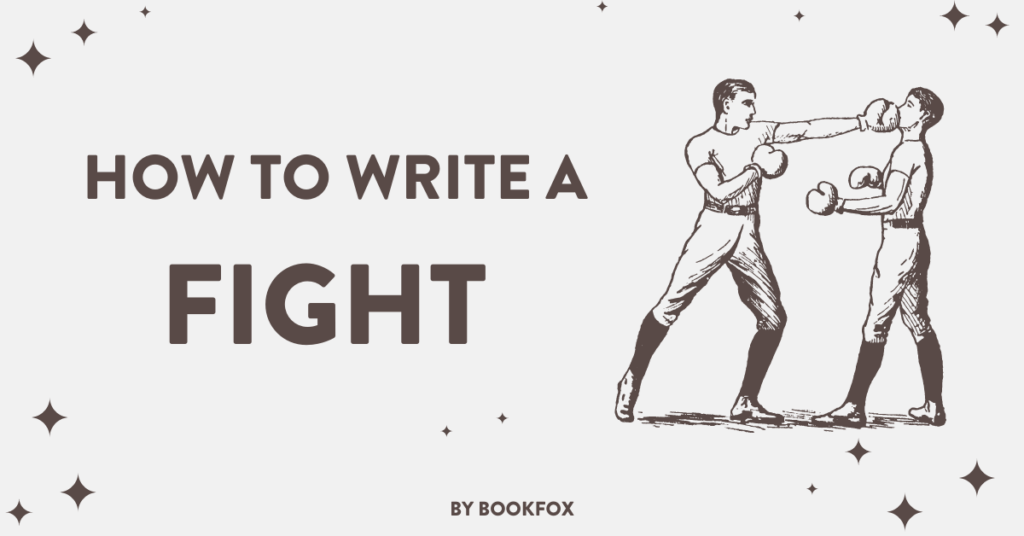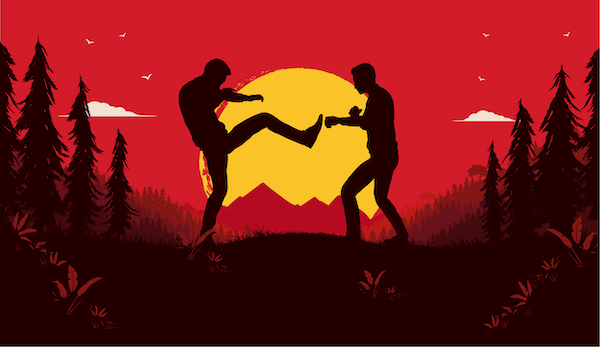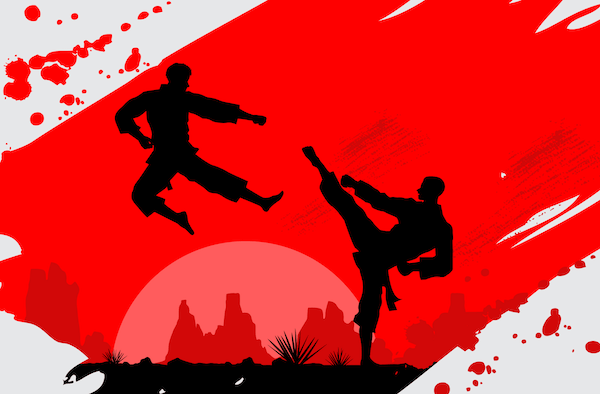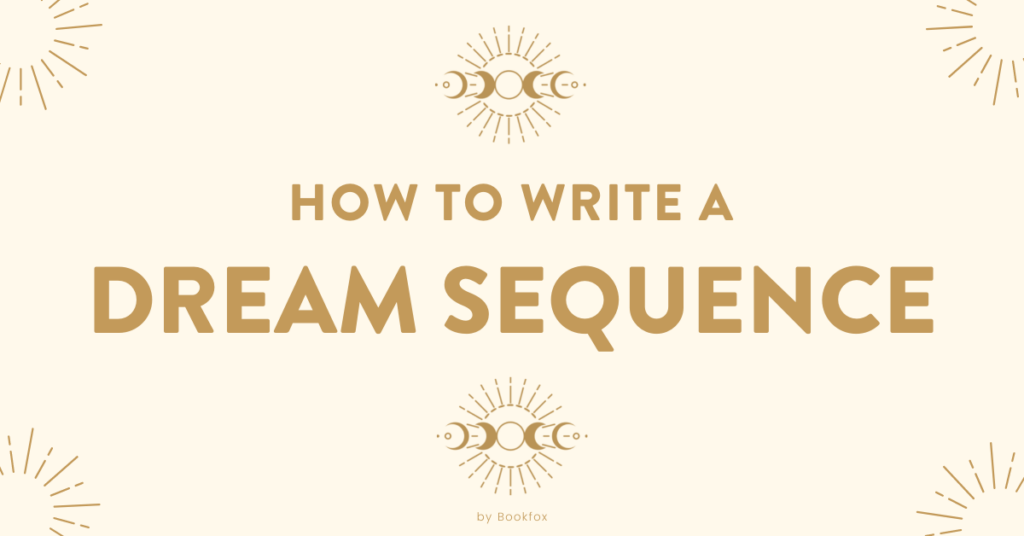
It’s time to write a big fight scene in your novel, but you don’t want to botch it.
That’s understandable. I’ve read enough badly written fight scenes to know that it’s truly easy to write a boring, predictable fight scene with nothing at stake, where the reader doesn’t even care who wins by the end.
But don’t worry — I’ve got your back with these 21 rules (more like guidelines, really).
And make sure to read and apply #19 — if you don’t use that advice, none of the other advice here will matter.
Also, if you’re looking for examples of fight scenes, I have some wonderful fight scene examples here on the blog. If you’re looking more for guide ropes and tried-and-true principles, then continue reading.
1. Fights are Stories
When I read badly written fight scenes, it’s usually because they’re not treating the fight as a micro story.
Imagine each fight scene as a mini Freytag’s pyramid — inciting incident, rising action, climax, resolution.
- You want to create rising action, where they are battling each other.
- You want twists and turns, where one character is winning and then the other one starts winning.
- You want a surprise — an extra knife, pulled out of the sock. Or an additional opponent joins the fray.
You also want to heighten each moment of the fight. At one point you really think one character will choke out the other, but then he hits him with a paperweight and escapes.
Always offer a climax– one pivotal move that beats the opponent, that is more powerful or significant than the previous moves.
And don’t miss the resolution. What happens afterwards? Does one of them leave? Do they dispose of the body? Do they offer mercy and leave them alive?

2. Avoid Nonstop Action
When beginning writers create fight scenes, this is their major problem.
They have action after action after action. The reader starts to feel dull with no variation except action.
- You have to layer in the sounds.
- You have to layer in the thoughts of the characters.
- You have to layer a sentence of description of the area around them.
It’s okay if you write all action in the first draft. That’s what first drafts are for — being terrible.
But flesh it out in your later drafts, adding all the tiny details that make the fight seem real. Action only works if your readers eyes don’t glaze over from repetition.
My writing teacher Janet Fitch used to call this type of writing “Frankenstein Writing,” meaning it’s just movement after movement, like Frankenstein lumbering onward. Purely physical writing is boring writing.
3. Know Your Weapons
If all you know about nunchucks is that one of the Teenage Mutant Ninja Turtles used them, you’re in trouble.
If you’re using a particular weapon like nunchucks, you have to know the names for certain moves, like the Helicopter Spin and the Figure Eight.
You have to know the type of mistakes that someone could make in a fight with such weapons that would allow an opponent to get an advantage.
You also have to know the different philosophies of how to use such weapons. Perhaps they trained with Sensai X, who focused on controlling breathing, or they are strikingly traditional in their use of a sword.
A spear, a quarterstaff, a knife, a bayonet, a tomahawk, a mace and chain — each of these has a specific fighting style, and will require deep research before you write the fight.
And if a person’s weapon is their body, you’ll have to study the martial arts: karate, kung-fu, muay Thai, jiu-jitsu, krav maga, boxing, judo. Study not just the physical movements but the ideas and strategies behind the movements.
4. Modulate Time
Bad fights scenes happens at clock speed.
Every real second takes about a second in the book.
What you should do is to speed up and slow down your fight scene. A very critical moment in your fight scene, when one character is about to be plunged off a cliff, or the momentum of the fight is about to change to the opposing character, is the perfect place to slow down.
Slow down by:
- Focusing on details/description
- Focusing on character thoughts
- Focusing on sensations they’re experiencing.
Conversely, if you have a more boring stretch of the fight, you could always speed it up. Summarize what each character does for five seconds. Move quickly through a back and forth where one character advances and then the other.

5. Don’t Write Movies
I know, I know: this seems like terrible advice. After all, your readers know movies and television. They know how the silver screen works.
Why would you want to avoid writing the type of fight scene they’re used to seeing in a film?
Well, because you’re not making a movie. You’re writing a book. And I probably don’t need to remind you, but these are different genres.
If you’re imagining a movie of your fight scene as you write, you’re guaranteed to write a bad fight scene. That’s because you can’t include all the rich visuals in a book. It just simply won’t work.
You have to take advantages of the benefits of text, of books, of the written language. For instance:
- The ability to slow down and speed up
- The ability to showcase thoughts
- The ability to use shorter and longer sentences to regulate the action
You cannot write a movie fight on the page, you can only write a book fight on the page. If you don’t know the difference, try reading a bunch of fights in books.
6. Change Momentum
Read any good fight scene and you will find shifts of momentum.
At one point, one character is winning, and through a well placed punch or gaining the high ground, the other character starts winning.
Boring fights are when both characters are evenly matched the entire way through.
Or even worse, a bad fight scene is when the reader can’t tell who is winning.
Important Rule of Thumb: after each sentence of your fight scene, the reader should be able to tell who is currently winning and who is losing.
Ideally, you’ll probably want five or six momentum changes in a fight, and perhaps more if the fight goes on longer (though I wouldn’t recommend too long of a fight).
In a movie, you can only show momentum changes through physical actions, but in a book you can change momentum by having a character feel fear or worry they’re outmatched (focus on thoughts). You can also give us the sensations of their exhaustion. You have have the sword feel heavier in their hand. You can have their eyes grow blurry.
7. Use Objects
Almost any good fight scene will include a number of objects.
And I don’t just mean the weapons.
I mean:
- Dirt gets thrown in someone’s eye
- A shard of broken glass is used as a knife
- A piece of rebar becomes a club
No matter what weapons you’re using in your fight scene, you can always add more, once their normal weapon gets knocked from their hand.
In fact, objects are often the swivel on which the entire fight swings. It’s going in the favor of one character, but when the other character grabs a Greek bust and bashes it over their opponent’s head. And bingo! The fight reverses course.
Consider adding two to four “prop” objects in your fight scene to liven things up (and it doesn’t have to be used as a weapon: a dinner tray could be a shield. A picnic table could provide a launchpad for an attack).
Quick reminder: if you’re looking for examples of fight scenes, the actual text from a novel, then you would want to click that link and go to my fight scene example page.

8. Create Imbalances
Remember the giant Fezzik and the masked pirate Wesley in The Princess Bride? (which was a great book by William Goldman, not just a movie).
What made that an interesting fight was you had very different strengths and fighting profiles.
- Fezzik had a huge amount of strength, but he was not very nimble.
- Wesley was not nearly strong enough to take Fezzik down in a fistfight or wrestling match, but he was quick, and he was also smart enough to get to his backside so he could choke him out.
You could also have imbalances in terms of experience and expertise.
If you have a suburban housewife facing off against a professional assassin, you have wonderful imbalance that you can exploit by having the housewife use kitchen knives and broomsticks. Also, with an imbalance, it’s even more surprising when the underdog wins.
Even if you have two professional assassins, you can create imbalances in other ways. In Robert Ludlum’s Jason Bourne books, Bourne didn’t know who he was or what he was supposed to be doing, which gave him a disadvantage against some of the professional assassins that came his way.
9. Show Character Change
What does your character learn during this fight?
What kind of epiphany or resolution do they have at a critical moment that allows them to win?
For instance:
- Your character thinks of their mother when they’re about to die, and that gives them the courage to summon reservoirs of strength
- The antagonist insults them, and they reject that insult, because they believe something differently about themselves, and it gives them the courage to throw off the opponent.
In this aspect, a fight is like a sex scene.
You shouldn’t be writing gratuitous sex scenes, and you shouldn’t be writing gratuitous fights. Both fights and sex scenes exist to tell us something about the character, something that we couldn’t learn in any other way.
Both fights and sex scenes are crucibles in which the authentic nature of the character is revealed.
10. Use Intermissions
A fight scene with thumping action every single second for pages and pages quickly gets boring. You want an intermission in the fight where they step back, both breathing hard, and evaluate their next move.
- Perhaps one character comes up with a new idea, or thinks that if she doesn’t kill him, he’s going to kill her child.
- Perhaps they see a fireplace poker in the room which they will use at the end of the fight to win.
- Perhaps they each get a line of dailogue.
An intermission allows the reader to breathe for a second, and allows them to anticipate what’s coming.
Also, an intermission helps to highlight the action parts of your fight. All fighting all the time leads to exhaustion on the part of the reader, and though they might not skip ahead, they won’t really remember what they’ve read.
Offering a pause helps you put a spotlight the most important parts of the fight.

11. Add Dialogue
It’s actually pretty rare to find a fight scene where characters don’t say anything to each other.
That’s because dialogue is one of the best tools in your toolbox to create emotion.
I’m not talking about full speeches, where the bad guy confesses their entire nefarious plan. I’m talking about a snippet of dialogue here, and a witty retort there.
Use dialogue in a fight scene to:
- break up the action
- highlight what the character really cares about
- deliver insults and powerful and quotable “gotcha” lines
Think about Princess Bride, when Inigo Montoya is fighting the six fingered man, and the six fingered man begs for mercy, saying he’ll give him money, power, and everything he asks for.
Inigo Montoya, in the climactic moment of the fights, says this as he stabs him: “I want my father back, you son of a b****”.
If he stabbed him without saying a word, we wouldn’t get nearly as much emotional satisfaction from the end of that revenge story.
Dialogue can also be used as a comeuppance at the end of the fight scene. Ian Fleming was actually great at letting his character Bond say punchy one-liners at the end of fights (as cheesy and punny as they often were).
12. Use Novelty
In Cormac McCarthy’s “No Country for Old Men,” part of the pleasure of the novel is the way that Chigurh uses a cattle gun to kill people.
He doesn’t use a gun. He doesn’t use a knife. No, he uses this metallic cannister that powers a bolt that shoots out of a handheld device at lightening speed. It’s the way they kill thousands of a cattle a day in a meat factory. Bolt in, brain scrambled.
For your fight, please don’t limit yourself to the typical weapons out there.
You need to be brainstorming long before you start writing to figure out a way for someone to fight that feels fresh.
The crazier the object, the better. Seek more original ways to use common, innocuous objects.
For instance, be like John Wick, and use a pencil to kill a man.
13. Make Mistakes
Have your characters make mistakes in the fights.
One character should be too aggressive, and that allows the opponent to take advantage.
One character should be too confident, which provides an opening, or too timid.
You could even have a character point out the mistakes that the other is making: “Don’t hold the knife up like a tomahawk. Hold it underhand, like so.”
If you’re writing from the point of view of a certain character, have them regret a mistake they make, worry that it will be their last one.

14. Escalate Wounds
It’s boring to write a fight scene where both characters are physically unharmed until someone wins at the end.
Ideally, the wounds will escalate over the course of the fight.
- Someone will get nicked on the shoulder, drawing first blood.
- Someone will have their leg numb from a kick, and have to limp
- Someone will get stabbed in the stomach and struggle to continue the fight.
Over the course of the fight, use wounds as a way to show who is winning, and frequently change who appears to be winning by adding more and more wounds, growing more and more serious.
Make sure to be creative with wounds, as well. I talked about objects above, and one object could be a beaker of acid, which burns or blinds a character. Wounds also include disorientation, dizziness, and exhaustion.
15. Build Characterization
Ideally, the type of fight and fighting style will reflect the personality of your character.
- If one character is truly honorable and decent, they won’t fight dirty. They’ll fight fair, and they’ll probably get taken advantage of.
- If your protagonist is more of an ends-justifies-the-means type of character, then they will be willing to eye gouge and groin-kick their way to victory.
You could also use a fight in order to show character change: perhaps a character has been very upstanding and play-it-by-the-rules type of personality, and suddenly in a fight they turn wild and unhinged and do whatever it takes. That means you’re using this fight as a moment when they evolve.
So a fight is not merely a way to advance the plot, but to deepen the characterization of your protagonist and antagonist.
16. Pick Good Locations
Location, location, LOCATION. You can’t have a good fight in a boring location.
Staging a good fight requires the support of the objects and topography at hand.
For instance, just try writing a fight near a cliff. Guess what? The entire fight will have much more tension because the entire time, the reader knows that someone’s falling off that cliff.
Or set a fight inside a museum, where the ancient swords or staffs inside the cases become utilized as weapons. Set it inside a:
- Laboratory where fluids and equipment become weapons, and where characters leap upon lab benches or hide inside machinery
- A campsite where canisters of propane gas become a weapon, and where they sprint around tents
- A car parking lot where broken antennas and pieces of glass and asphalt burns become part of the fight
17. Create Stakes
What happens if one character loses the fight? What happens if the other character does?
The reader must know what is at stake, and it’s best if death is not the only downside. (death/injury is fairly obvious in a fight as a downside. Be more creative).
For instance, if they lose:
- They know that the antagonist will kill their families or set off a bomb in downtown Los Angeles.
- They know they’ll lose their job or their money
- They will be humiliated in front of their friends, peers, and wife/husband
- They will fail to avenge their lover’s death or a promise made to their mother
Don’t feel like you have to stop at one important stake. The more things you have at stake, the better.
For instance, if a character loses this fight, they know that they’ll die, their family will die, and their business will fail.
That’s a lot at stake, and that means the reader HAS to care about the outcome. You’ve just made this fight essential reading, congratulations.

18. Make it Messy
Fights are usually not perfectly choreographed set pieces. They are raw disasters with people tripping and wild swings and characters accidentally cutting themselves.
Unless you have two very honorable fighters who have practiced for this their whole lives, then you need a messy fight scene where nothing goes right and stumbling and foibles are the norm.
It’s important to mess with consciousness as well.
Your character should suddenly realize his opponent is at his neck and not know how they got there so quick. She should blank out for a moment, not because she was hit, but because in the heat of the moment she didn’t remember swinging the beam of wood at the other person’s head.
Also, afterwards, your character should struggle to remember exactly how it happened. Perhaps there is a blank in their memory when it comes to a certain pivotal moment of the fight.
With that much adrenaline running through your system, your body sometimes goes on autopilot.
19. Forward the Plot
How do you know if you need a fight scene?
Well, try this test: If you removed this fight scene from the book, would the book’s structure collapse?
This fight has to be a hinge on which your plot swings, and you can’t get the reader from point A to point B without it. This fight has to be the doorway through which the protagonist passes to get to their final destination.
That means a fight is only necessary if it:
- leads to the next stage of the investigation
- gets an obstacle out of the way
- gives them a clue in their attacker’s pocket that they can follow
20. Avoid the Unbelievable
It beggars belief when a hundred and thirty pound woman is tearing through two hundred pound dudes like they are paper mache. Even if she does have significant training, you have to pay attention to weight class differences.
There’s a reason that one of the greatest boxers of all time, Floyd Mayweather, couldn’t knock out Youtube star and largely untrained boxer Logan Paul, and it’s because Logan Paul weighed 35 pounds more (FOUR weight classes above him!).
Gender differences do exist. Muscles and weight do matter.
In the case of assymetrical bodies, try to come up with asymmetrical fighting styles.
Perhaps a much lighter opponent will not be able to wrestle the much bigger opponent down to the ground, but they can break a rib or twist a wrist. Or give them a weapon that evens out the fighting field.
21. Show Intelligence
It seems counter-intuitive in a physical fight, but this is one of the best places to show your character is smart.
Your character should be fighting with their head, not just with their body.
They should be resourceful and find ways to:
- Trick their opponent, through a feint or distraction
- Use the environment and objects around them to get an advantage
- Plan ahead and use ingenious and surprising methods to achieve victory
Forgive me for using a movie example, but think of Robert Downey Jr. in the first Sherlock Holmes movie, during that bareknuckle brawl.
Before the sequence that leads to him winning the fight, the voiceover shows him plotting out every move, calculating how to take breath away and make his opponent lose his footing, all before the climactic haymaker.
And of course Sherlock Holmes would fight in an intellectual way, but I think any protagonist should as well.



One thought on “21 Rules to Write a Fight Scene”
Absolutely amazing tips! Thanks so much, Bookfox.